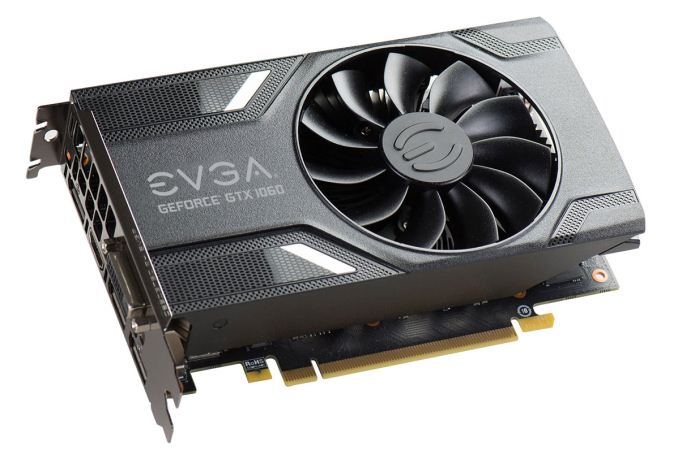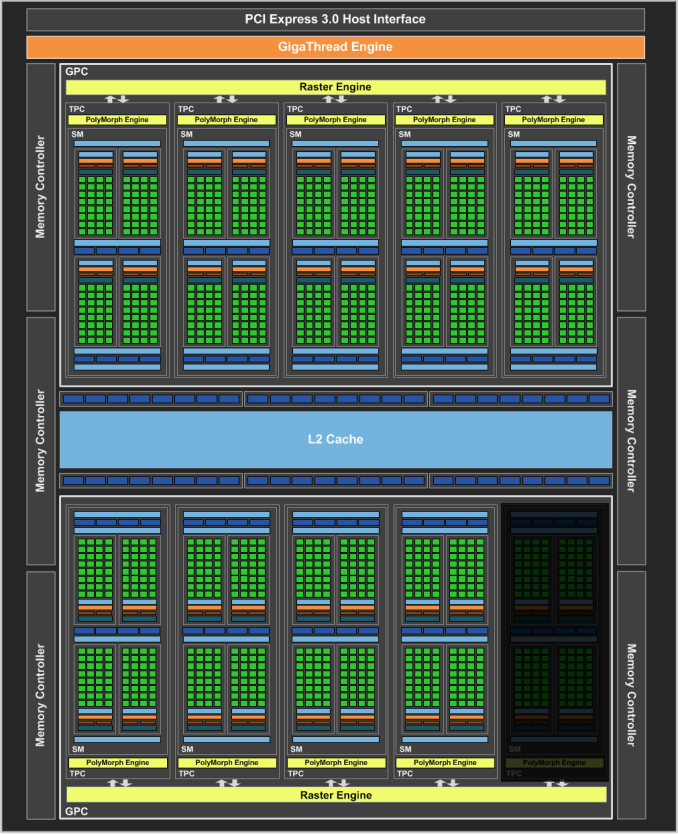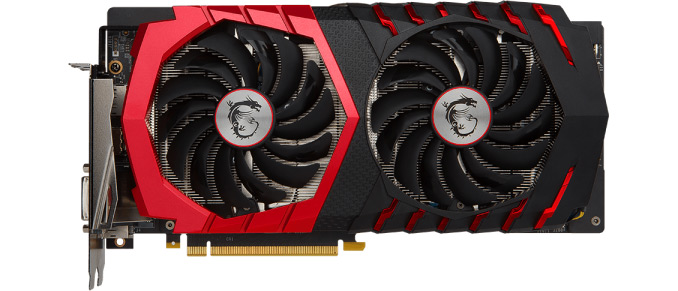NVIDIA Releases GeForce GTX 1060 3GB: GTX 1060, Yet Not
by Ryan Smith on August 18, 2016 6:15 PM EST
In a low-key press blast sent today, NVIDIA has announced that they are expanding the GeForce 10-Series of cards with another entry. Augmenting the current series of cards is a second GeForce GTX 1060, the GeForce GTX 1060 3GB, which despite the name is not actually equal to the original, 6GB GeForce GTX 1060. The new GTX 1060 3GB is available immediately from retailers starting at $199.
| NVIDIA GPU Specification Comparison | ||||||
| GTX 1070 | GTX 1060 6GB | GTX 1060 3GB | GTX 960 | |||
| CUDA Cores | 1920 | 1280 | 1152 | 1024 | ||
| Texture Units | 120 | 80 | 72 | 64 | ||
| ROPs | 64 | 48 | 48 | 32 | ||
| Core Clock | 1506MHz | 1506MHz | 1506MHz | 1126MHz | ||
| Boost Clock | 1683MHz | 1709MHz | 1709MHz | 1178MHz | ||
| TFLOPs (FMA) | 6.5 TFLOPs | 4.4 TFLOPs | 3.9 TFLOPs | 2.4 TFLOPs | ||
| Memory Clock | 8Gbps GDDR5 | 8Gbps GDDR5 | 8Gbps GDDR5 | 7Gbps GDDR5 | ||
| Memory Bus Width | 256-bit | 192-bit | 192-bit | 128-bit | ||
| VRAM | 8GB | 6GB | 3GB | 2GB | ||
| FP64 | 1/32 | 1/32 | 1/32 | 1/32 | ||
| TDP | 150W | 120W | 120W | 120W | ||
| GPU | GP104 | GP106 | GP106 | GM204 | ||
| Transistor Count | 7.2B | 4.4B | 4.4B | 2.94B | ||
| Manufacturing Process | TSMC 16nm | TSMC 16nm | TSMC 16nm | TSMC 28nm | ||
| Launch Date | 06/10/2016 | 07/19/2016 | 08/18/2016 | 01/22/2015 | ||
| Launch Price | MSRP: $379 Founders $449 |
MSRP: $249 Founders $299 |
MSRP: $199 | $199 | ||
Looking at the big picture, the new GTX 1060 3GB materially differs from the existing 6GB GTX 1060 in two different metrics. First and foremost of course is the memory; the card ships with half as much memory, which amounts to a 6x512MB configuration. However, somewhat frustratingly, NVIDIA didn’t just stop there and has also introduced a new GPU configuration for this card, meaning that we are now looking at multiple GPU configurations being sold at retail under the GTX 1060 banner.
Whereas the original GTX 1060 6GB shipped with a fully enabled GP106 GPU, the GPU used in the GTX 1060 3GB ships with 1 of the 10 SMs disabled. This leaves 9 SMs enabled, leading to a CUDA core count of 1152, and 72 texture units. Other than this sole disabled SM, the GPU is otherwise untouched, and the full ROP/L2 backend and its associated memory controllers are fully enabled.
Clockspeeds are also unchanged. On the GPU this means we’re still looking at 1506MHz base and 1709MHz boost. Meanwhile on the memory it’s still 8Gbps GDDR5 on a 192-bit memory bus, only now there’s only half as much total memory. Consequently the total performance hit to the GTX 1060 3GB as compared to the original GTX 1060 6GB will be a combination of the reduced memory capacity and the loss of 10% of the shading/texturing/geometry resources.
Finally, on the TDP side, TDP hasn’t been adjusted even with the loss of 1 SM. This means TDP remains at 120W. I suspect part of this comes down to the fact that NVIDIA isn’t doing additional power binning (ala GTX 1070), along with the fact that disabling a single SM is going to have a limited impact on power consumption.
All told, this is a typical case of NVIDIA creating a new SKU for salvaged GPUs. Since the full-fledged GTX 1060 uses an equally full-fledged GP106, this gives salvaged GP106s a card to use them in.
The concern I have is that, frankly, I thought NVIDIA was done with these shenanigans, as they haven’t had multiple GPU configurations selling under a single retail GTX model number for a number of years now. To the company’s credit, they are drawing a clear line between the 3GB and 6GB cards – there will not be any 6GB cards with a cut-down GPU, nor any 3GB cards with the full GPU – but the memory configuration now means something about how the GPU is configured, which is unintuitive at best (ed: and this doesn’t give AMD a free pass on the RX 480 either). Ultimately I’m not sure that anything good can come from this, and that the part should have been GTX 1055 or such.
Meanwhile the performance impact, according to NVIDIA, should be about 5%. Keeping in mind that GTX 1060 3GB is losing 10% of its shader/texture/geometry capacity and none of its ROP or rasterization capacity, this doesn’t seem unrealistic. Though it’s obviously something we’ll want to test ourselves.
As mentioned earlier, this is a hard launch for NVIDIA and its partners. MSI, Gigabyte, EVGA, and others are already listing cards on Newegg, and as of this afternoon they are still in stock, which is better than any previous 10-Series launch. Even the base-bones $199 GTX 1060 3GB cards are in stock, so it’s possible to pick up a card at MSRP. Though the partners also have a number of factory overclocked cards, in case you wish to spend more than $200.
Competitively speaking, the GTX 1060 3GB is meant to compete against the $199 4GB Radeon RX480, the cheaper of AMD’s RX 480 lineup. The latter has been in very short supply since its launch, so at this second NVIDIA has a pretty solid grip on the $199 price point at this secnd.
At the same time however, I do have some concerns about whether a 3GB card is enough, especially looking at a year or so down the line. The 2GB GTX 960, by comparison, has shown us that buying a low capacity card can be short-sighted, as the 4GB versions have held up better in 2016’s major game releases. But to the credit of NVIDIA and their partners here, they are at least being aggressive on pricing, with the slight downgrade from the 6GB to the 3GB card shaving 20% ($50) off of the MSRP of the card.
Finally, on a housekeeping note, NVIDIA has not sampled the 3GB cards to the press, as this is a pure virtual (partner-driven) launch with no reference board or Founders Edition equivalent. So you’ll see reviews over the coming days and weeks as partners directly sample cards instead.
| Summer 2016 GPU Pricing Comparison | |||||
| AMD | Price | NVIDIA | |||
| $439 | GeForce GTX 1070 | ||||
| Radeon R9 390X | $329 | ||||
| Radeon R9 390 | $299 | ||||
| $249 | GeForce GTX 1060 6GB | ||||
| Radeon RX 480 (8GB) | $239 | ||||
| Radeon RX 480 (4GB) Radeon RX 470 |
$199 | GeForce GTX 1060 3GB | |||












124 Comments
View All Comments
stardude82 - Friday, August 19, 2016 - link
The Kepler GT 730 is sort of an important part as it is the best card you can find at the 25W point which is the limit for a non-PEG slot. It'll handle Source based games fine.BrokenCrayons - Friday, August 19, 2016 - link
I have a GT 730 with 1GB GDDR5. Based on my gaming experiences so far, I've had few to no problems running most modern games as long as I keep the resolution down to 1366x768 and don't turn on AA which is a highly unnecessary feature anyway. Other settings can wander upward toward the higher end. It's a pretty good GPU though I do regret not picking up the 2GB GDDR5 version for a little more cash.In my experience, people in the AT comments box tend to vastly overestimate the amount of GPU they "need" to be entertained and have a pretty unrealistic understanding of how good things are in the $60 GPU universe. It's not a perfect experience and I am going to forgo playing a few games until I get around to buying a newer more powerful low end GPU...though I admit that computers have become a lot more of a dissatisfaction than a source of entertainment since Microsoft went over to the Dark Side to mine data from their users so I'm heavily leaning toward Linux-ing my desktop and playing Tux Racer for the rest of my life.
yannigr2 - Friday, August 19, 2016 - link
That GT 730 is a great little card for what you do. The 40GB/sec bandwidth is enough for most games at 768p resolutions and lower setting. If you where unlucky to choose the DDR3 Kepler version, which comes with 14GB/sec bandwidth at best, you wouldn't be able to play at any resolution without dialing all settings to low and accepting framerates between 10 and 30 fps.Icehawk - Saturday, August 20, 2016 - link
I honestly can't remember the last time I gamed at 1366x768, sometime well before 1998 though. Personally I would find that to be a terrible experience - I am gaming at literally 2x that resolution. Nor would I accept any settings below Medium and at that point I am considering my next card upgrade. Of course I am not in the same market or price bracket and if you are happy that is great.I play at QHD, High or greater settings, and AA (which is necessary unless you like jaggies even at high resolution and more so at lower ones)? I have a 970 and that's the minimum I would suggest for that setup unless you like a slide show. 1080p or below, and yes, the firepower needed is less but for AAA titles I still wouldn't go below a GTX660.
I would venture a large percentage of AT posters play AAA titles at 1080p, High settings, and some AA at the minimum and that is why you are seeing folks like me who think a 730 is essentially worthless.
And yes, I guess I could be "entertained" for less, I mean I used to be pretty thrilled with no color text games (hello Zork!)... but I need to get my Overwatch, No Man's Sky, Doom, etc on.
yannigr2 - Friday, August 19, 2016 - link
It's the best card if it is the GDDR5 version. The DDR3+Kepler version is just a modern G210.yannigr2 - Friday, August 19, 2016 - link
Most people wanting to just defend Nvidia's business choices, where responding with a "who cares, it's a low end card". Well, unfortunately the low end graphics card category is no longer important, which means, that whatever tricks companies where doing in the sub $100 market, they are coming soon to the sub $200 market. That's why you never say "who cares about that card".And you are wrong. You can happily play on the GDDR5+Kepler card. it's a fast little card that will let you even to enable some medium quality options in modern games and still get nice framerates over 30fps. You can't play with the DDR3+Kepler version of the card. It comes with only 14GB/sec memory bandwidth, which means that you can play only some extremely light games that will be happy for example with an old GT 220. Except if you like playing at 15fps.
Ryan Smith - Friday, August 19, 2016 - link
"Most sites pretend to ignore the existence of GT 730."The GT series is its own bag of crazy. Which is why I specifically mention the GTX series here, as these shenanigans shouldn't be happening with NVIDIA's premium cards.
yannigr2 - Friday, August 19, 2016 - link
Well APUs and Intel's integrated graphics are killing the low end market. So, this bag of crazy is coming to lowest GTX models now.Nvidia brought Titan to the market because it needed to start recreating(8800GTX Ultra anybody?) some higher price points. So they first brought Titan and then the hi end Ti card. So, while in the past you only had one hi end model, GTX 480 for example, now you have three. GTX 1080, the New Titan X and the GTX 1080Ti that will probably come latter.
So, Nvidia is moving it's products at higher price points. And it doesn't drop the GTX name in the lowest models probably because of marketing reasons. I am not expecting a GT 1040 and the 1050 is coming as a GTX. For me there is nothing strange looking at two different GTX 1060's. I have seen it before. Yes in cheaper cards, but as I said in the beginning there is no low end market anymore. There could be, if GTX 1050 and RX 460 where costing $60. Well, they don't.
extide - Saturday, August 20, 2016 - link
Well, unfortunately that happens all the time in those low end GPU's which seem to be made from whatever is laying around at the time. I specifically remember this site lambasting them for this practice in the past, not sure if it was the GT730 scenario or not, but the point is no this isn't the first time they have bitched about it.MrSpadge - Friday, August 19, 2016 - link
"Clockspeeds are also unchanged... Consequently the total performance hit to the GTX 1060 3GB as compared to the original GTX 1060 6GB will be a combination of the reduced memory capacity and the loss of 10% of the shading/texturing/geometry resources."The disabled SM reduces the power consumption (everything else kept similar), so the card can boost higher for a given power target. That's likely the main source of "10% less shading/texturing/geometry resources causing a 5% performance drop".